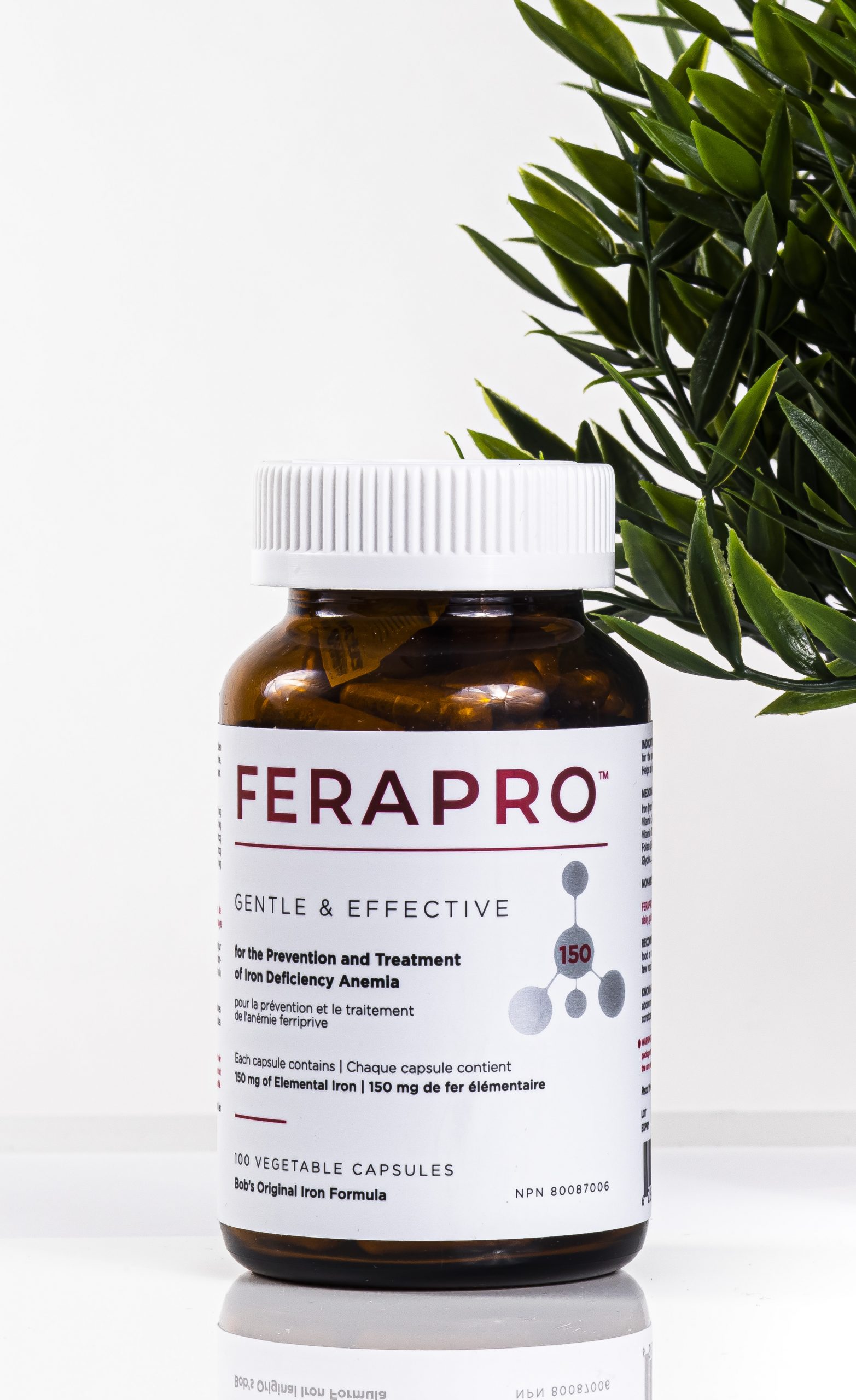FAQs
- Home /
- Page
Frequently Asked Questions
Iron Deficiency Anemia
Iron is essential for everyone. It is an important mineral needed to produce hemoglobin, which is key to carrying oxygen in the blood from your lungs to the rest of your body. It is used to make myoglobin which supplies oxygen to your muscles. Iron is also used in making DNA and producing energy at the cellular level.
Iron deficiency anemia is the most common nutritional deficiency in the world. It happens when your iron is low enough that your body is unable to supply enough new red blood cells. With fewer healthy red blood cells, your blood has a reduced ability carry oxygen throughout your body. This will generally manifest as the fatigue we all know too well, but it can also show up as general weakness, light-headedness, pale skin, intolerance to cold or dizziness.
Iron deficiency is more common in young children aged 0 to 5 years, pregnant women, those of you who follow vegetarian diets.
The average adult female requires 18 mg of dietary iron per day, whereas an average adult male requires only 8 mg daily. As a result, iron deficiency anemia is more common in women.
Usually through a blood test. It can be very hard to differentiate between fatigue brought on by low thyroid hormones or due to low levels of vitamin B. A blood test will reveal that your red blood cells and serum ferritin are low. Ferritin is the storage form of iron and when iron is depleted, we already know that the body can’t make enough red blood cells to carry oxygen to energize you.
Mild iron deficiency anemia seldom leads to complications. Left untreated, iron deficiency anemia can lead to serious health problems such as irregular heart beats which can be fatal. In pregnant women, this can lead to premature births and low birth weights.
We first try to treat the underlying cause of low iron. For most people, this means increasing your intake of foods that have high iron content. Beef, pork, chicken and most seafoods are a good source of iron. Vegetarians can eat more tofu, spinach chickpeas, or soybeans. Other causes are bleeding disorders from trauma, menstruation, or medications. Some of you may have conditions that affect your absorption of iron, such as celiac disease or H.pylori infection. It is best to see your doctor to assess you. Once they determine that you have iron deficiency anemia, you can be started on iron supplements. Most guidelines recommend that an adult take 100 to 200mg of elemental iron per day.
Basically, iron comes as two forms as heme iron derived from meat and non-heme iron found in vegetables. Heme iron is better absorbed, but you only get 11mg per tablet, so this is better if you’re looking to prevent anemia. Nonheme iron comes in many different salts, but ferrous iron is the best absorbed. Other forms like ferric iron from plants need to first be converted to ferrous iron before it can be absorbed. Don’t take iron without first seeing your healthcare provider.
You are more likely to have side effects from iron if you take a higher dose. This includes nausea, upset stomach, constipation, or darkened stools. Liquid iron formulas can stain your teeth, so I always recommend taking that through a straw and rinsing with plenty of water or orange.
Iron supplementation correct your anemia causing fatigue within two to four months, but you may need to continue taking supplements for another three to six months to replenish iron stores.
Vitamin C enhances iron absorption. I like to recommend taking iron with a glass of orange juice after a meal. You get less iron absorption with food, but this minimizes side effects.
Only ferrous iron (Fe2+) can be absorbed. Polysaccharide iron supplements provide ferric iron (Fe3+), which as I mentioned previously, need to first be converted in the stomach before it can be absorbed.
And lastly, always space iron apart from drugs and supplements, especially ones containing calcium or magnesium such as multivitamins or antacids. These will bind to the iron and prevent it from being absorbed.
FERAPRO™
The iron in FERAPRO™ come from ferrous fumarate. As a ferrous iron, it is more bioavailable than ferric iron, which must to be converted to the ferrous form in gastric enterocytes prior to absorption in the GI tract. At 150mg of elemental iron, this is the highest amount of iron available in oral form, allowing for convenient once daily dosing. FERAPRO™ is also available as 30mg and 75mg, allowing for individualization of dosing for patients.
There is also great supporting literature that the enzyme ascorbate ferrireductase uses ascorbic acid to enhance non-heme iron bioavailability by 1.5 to 10-fold. Glycine is an amino acid that forms a chelated complex with iron, increasing its tolerability without hindering absorption.
As mentioned previously, methylcobalamin and 5-methyltetrahydrofolate, the active forms of Vitamin B12 and folic acid, support the growth and function of healthy red blood cells, especially for poor methylators such as those with 5-MTHFR mutation.
FERAPRO™, to my knowledge, is the only iron supplement with only one non-medicinal ingredient: hypromellose, an excipient that helps with controlled delivery.
Almost every other iron supplement on the market will include multiple non-medicinal ingredients such as dyes, gelatin, lactose, magnesium stearate, sodium lauryl sulfate, talc, the list goes on. If you have the option, why not avoid unnecessary ingredients?
Any iron supplement can cause constipation, darkened stools, and GI upset. This is generally proportional to the dose of elemental iron taken, but in FERAPRO™ this is offset with amino acid glycine. Of course, we can’t compare its tolerability to a supplement that only provides 10 to 15mg of iron to the profile of 150mg of FERAPRO™.
FERAPRO™ is vegan and also free of dyes, preservatives, corn, dairy, gluten, and soy.
It was originally formulated in 1997 to treat iron deficiency anemia in pregnant women who weren’t able to tolerate the doses of iron recommended by their doctors and midwives. For the past two decades thousands of pregnant women have safely used this formula.
FERAPRO™ should be taken with food to lessen gastrointestinal side effects such as nausea/vomiting and abdominal cramping. Certain minerals like calcium, aluminum and magnesium inhibit absorption of iron, so I usually recommend a 2 hour gap from dairy products, tea and coffee, and medications like antacids, bisphosphonates, levothyroxine, or tetracyclines.
Selecting the right iron supplement normalizes hemoglobin and corrects anemia within two to four months. If the change is not satisfactory, a higher dose should be tried. Even after erythropoiesis normalizes, supplementation should continue for another three to six months to replenish iron stores. My recommendation is to follow up with your physician so your ferritin level can be reassessed after 3 months of regular supplementation.
Yes, all three strengths of FERAPRO™ are available in child-resistant packaging.


Dr. Bryn Hyndman’s answers to your frequently asked questions about Iron Deficiency Anemia and FERAPRO®.
Dr. Bryn Hyndman, MD, ND
FOUNDER, VANCOUVER FUNCTIONAL MEDICINE
MEDICAL ADVISORY BOARD MEMBER, FERAPRO®
DALHOUSIE UNIVERSITY, B.SC., 2000
BOUCHER INSTITUTE OF NATUROPATHIC MEDICINE, ND, 2005
MATTHEW’S UNIVERSITY MEDICAL SCHOOL, MD, 2011
UNIVERSITY OF OTTAWA (FAMILY MEDICINE RESIDENCY), CCFP, 2014
THE KALISH INSTITUTE, FUNCTIONAL MEDICINE, 2014-2015
DR. HYNDMAN IS BOARD-CERTIFIED WITH THE CANADIAN COLLEGE OF FAMILY PHYSICIANS (CCFP).

